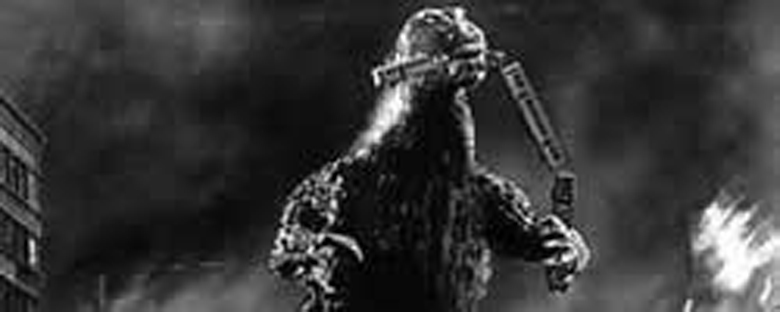Reviews
Gojira
Ishirô Honda
Japan, 1954
Credits
Review by Leo Goldsmith
Posted on 11 July 2004
Source Rialto Pictures 35mm print
Deep in the recesses of the Internet there are dozens of helpful strangers who offer instructions on how to construct your very own Godzilla outfit, so that anyone can realize one’s Tokyo-crushing dreams. Of course, given the opportunity, who would not want to tower hundreds of feet above a major city, knocking over its buildings and trampling its inhabitants underfoot? Homer Simpson certainly would: pondering the question of how he might spend $130 million if he won the lottery, Homer imagines himself twenty stories tall, bejeweled and plated in 14-karat gold, laughing maniacally as he towers over the city of Springfield. Tim Burton’s Pee-Wee’s Big Adventure features not one, but two such fantasies of gigantism. And touring major cities throughout the country, Boston’s Kaiju Big Battel (www.kaiju.com) features an absurdist brand of giant-monster wrestling, with participants dressed up as colossal insects, plantains, and cans of soup, crushing cardboard cityscapes as well as each other.
Godzilla, who celebrates his fiftieth birthday this year, is solely to blame. Certainly, there were many enormous monsters that predated Godzilla (King Kong being the most obvious), but none has had the longevity, the charisma, or the sheer volume of sequels as the “King of the Monsters.” Kong was a romantic, a simple brute with a thing for blondes; Godzilla had an incomparable malice, a toughness and a craving for destruction matched only by his innumerable (and increasingly preposterous) adversaries.
In Godzilla’s half-century, American audiences are treated to a much darker aspect of the monster’s character that had hitherto remained hidden. For the first time, Ishiro Honda’s original Gojira is playing in American theatres (taking the place of Terrell O. Morse’s heavily cropped and Americanized version, Godzilla: King of the Monsters), revealing the biting social commentary in the monster’s origins. To contemporary Western audiences, the sight of a man in a rubber lizard costume trampling a miniature of Tokyo will seem quite comic (if not flat-out hilarious), but the original Godzilla is nonetheless quite a grave affair, making the link between the monster’s rampage and the nuclear destruction of Hiroshima and Nagasaki morbidly explicit.
Honda’s film opened to Japanese audiences just nine years after the close of the Second World War, with the after-effects of the atomic bomb and American nuclear weapons testing in the Pacific still very much in the news. Early in the film, a jaded Tokyo commuter sets this scene when she complains of contaminated water supplies, radioactive tuna, “and now, to top it all off … Godzilla.” The monster’s arrival, at the height of H-bomb tests in the Pacific, is the next in a series of deadly misfortunes that nuclear proliferation is visiting upon the people of Japan.
But does Godzilla represent “the bomb”? Yes and no. Certainly, the monster’s thorough sacking of Tokyo is seen in its aftermath as a site of total nuclear devastation, complete with make-shift clinics, grieving families, and orphans with radiation sickness. And yet, in spite of this, the film makes clear that the monster is merely a product of the bomb, one that extends its deadly effects. Godzilla is thus not the instigator of massive destruction; he is one of its many far-reaching upshots, the next in a series of disasters that will continue to mount with the arms race. At the film’s close, Takashi Shimura (fresh from his work in The Seven Samurai, released by Toho Studios the same year) delivers the film’s moral: that with nuclear escalation and the continued development of more capable bombs, there would be more Godzillas to come.
Surely, Shimura’s mild-mannered paleontologist did not predict that the bomb would spawn quite so many sequels, let alone an entire menagerie of enormous beasts from Monster Island: giant moths, metal Godzillas, and so on. These additional installments in the series further diluted the serious intents of the original film, eventually making Godzilla not merely a star, but a hero. Who can say at what point Japanese audiences stopped identifying with the hordes of screaming people, terrified at the prospect of being crushed, burned alive, or infected with radiation sickness, and started rooting for the monster?
Seeing no profit in nuclear hysteria, the American distributors excised these anti-bomb overtones from the original American release. With Occident-friendly overdubs and a prolonged cameo by Raymond Burr (as an American reporter-on-the-scene named “Steve Martin”), Morse’s Godzilla has survived for the last half-century as a fairly innocuous piece of camp, devoid of the original film’s ethical quandaries. This Americanization of Godzilla has been a great loss to Western filmgoers, because the original version is as significant an anti-nuclear film as Dr. Strangelove. And in spite of its campy special effects, its dated romantic subplot, and its preposterous science, the film remains truly disturbing in its metaphoric implications. Now that Honda’s original film is available to us, Godzilla’s importance, as a historical document as well as a film, can be recognized.
We don’t do comments anymore, but you may contact us here or find us on Twitter or Facebook.



